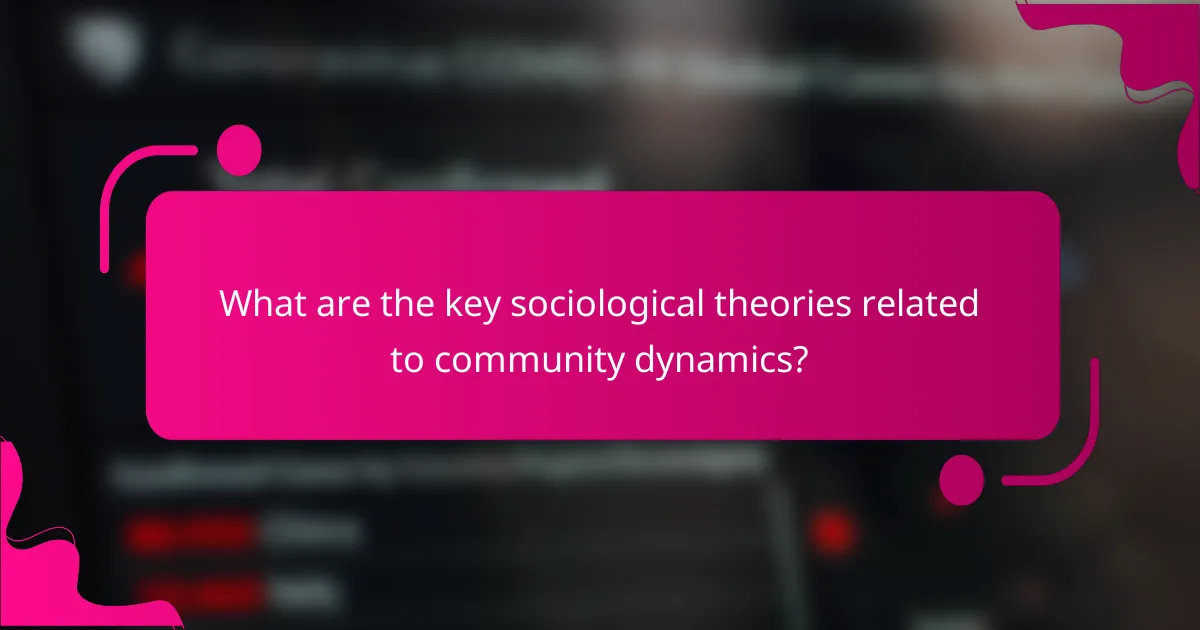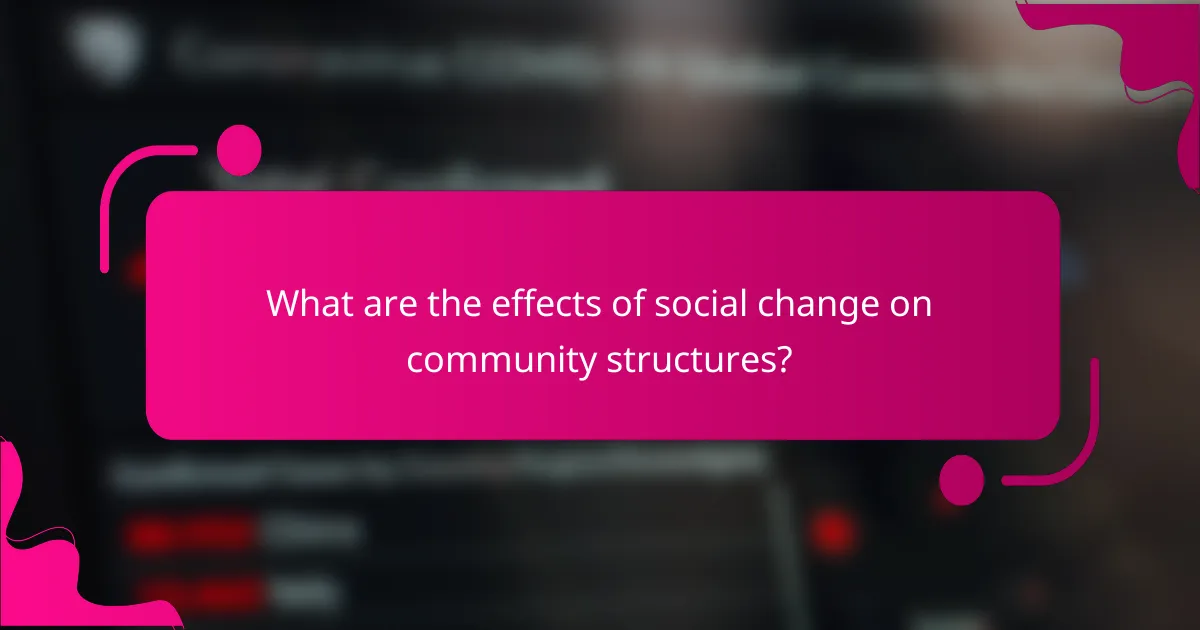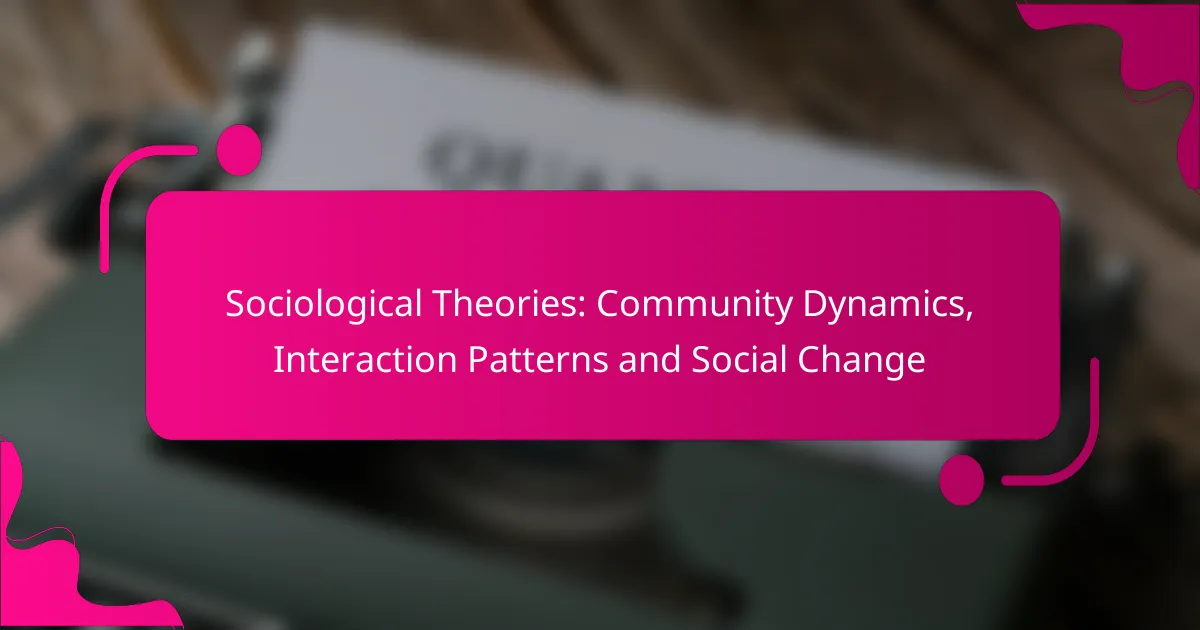Sociological theories provide valuable insights into community dynamics, interaction patterns, and the processes of social change. By examining how individuals engage within their communities and the strength of their social networks, we can better understand the factors that drive collective action and influence public policies. Key frameworks such as Social Capital Theory, Structural Functionalism, and Conflict Theory highlight the complexities of community interactions and their implications for societal transformation.

How do community dynamics influence social change in the United States?
Community dynamics play a crucial role in shaping social change in the United States by fostering collective action and influencing public policies. The interactions among community members, their engagement levels, and the strength of social networks can significantly impact how communities respond to social issues and drive transformation.
Impact of community engagement
Community engagement is vital for initiating social change, as it encourages participation in local governance and civic activities. When residents actively engage in their communities, they are more likely to advocate for policies that reflect their needs and values.
Effective community engagement can take various forms, including town hall meetings, volunteer initiatives, and local advocacy groups. These activities not only empower individuals but also create a sense of belonging and shared purpose, which can lead to more significant social movements.
Role of social networks
Social networks are instrumental in facilitating communication and collaboration among community members. Strong connections within a community can enhance the flow of information, making it easier for residents to mobilize around common causes.
These networks often serve as platforms for organizing events, sharing resources, and amplifying voices. For instance, social media has become a powerful tool for communities to rally support for social issues, enabling rapid dissemination of information and fostering solidarity.
Case studies in urban areas
Urban areas in the United States provide rich examples of how community dynamics can lead to social change. For instance, the community-led initiatives in cities like Detroit have focused on urban agriculture and neighborhood revitalization, demonstrating how local efforts can address food insecurity and economic challenges.
Another example is the grassroots movements in cities such as Chicago, where residents have organized to combat gun violence through community policing and youth programs. These case studies highlight the importance of localized approaches to social issues and the potential for communities to drive significant change through collective action.

What are the key sociological theories related to community dynamics?
Key sociological theories related to community dynamics include Social Capital Theory, Structural Functionalism, and Conflict Theory. Each of these frameworks offers distinct perspectives on how communities operate, interact, and evolve over time.
Social Capital Theory
Social Capital Theory emphasizes the value of social networks and relationships within a community. It suggests that individuals can leverage their connections to access resources, information, and support, which enhances overall community well-being.
Communities rich in social capital often exhibit higher levels of trust, cooperation, and civic engagement. For example, neighborhoods with active community organizations tend to have lower crime rates and better public health outcomes.
To build social capital, focus on fostering relationships through community events, volunteer opportunities, and local initiatives. Avoid isolation by encouraging participation and inclusivity among diverse groups.
Structural Functionalism
Structural Functionalism views communities as complex systems where various parts work together to maintain stability and social order. Each component, such as family, education, and economy, plays a specific role in supporting the community’s overall function.
This theory suggests that social change occurs gradually as communities adapt to new challenges. For instance, the introduction of technology may shift job markets, requiring educational institutions to evolve to meet new workforce demands.
To apply this theory, assess how different community elements interact and support each other. Identify potential disruptions and consider how to reinforce the community’s structure to maintain harmony and functionality.
Conflict Theory
Conflict Theory focuses on the power dynamics and inequalities within communities, highlighting how different groups compete for resources and influence. This perspective suggests that social change often arises from conflicts between those in power and marginalized groups.
For example, urban communities may experience tension between developers and residents over land use, leading to protests or policy changes. Understanding these conflicts can help identify underlying issues and drive social reform.
To effectively engage with Conflict Theory, recognize the interests of various community stakeholders. Facilitate dialogue between conflicting parties to promote understanding and seek equitable solutions that address power imbalances.

How do interaction patterns shape community relationships?
Interaction patterns significantly influence community relationships by establishing the ways individuals connect, communicate, and collaborate. These patterns dictate social dynamics, affecting trust, cooperation, and conflict within the community.
Types of social interactions
Social interactions can be categorized into various types, including cooperative, competitive, and conflictual interactions. Cooperative interactions foster collaboration and mutual support, while competitive interactions often drive individuals to outperform one another. Conflictual interactions can lead to tension and division, impacting overall community cohesion.
Understanding these types helps communities identify their strengths and weaknesses in social dynamics. For instance, a community with high levels of cooperative interactions may experience enhanced social capital and resilience.
Influence of cultural norms
Cultural norms play a crucial role in shaping interaction patterns by establishing expectations for behavior within a community. These norms dictate how individuals communicate, resolve conflicts, and build relationships. For example, in collectivist cultures, group harmony is prioritized, leading to more cooperative interactions.
Communities that embrace diverse cultural norms may experience richer interaction patterns, as individuals bring various perspectives and practices. However, conflicting norms can also lead to misunderstandings and social friction, necessitating effective communication strategies to bridge differences.
Examples of interaction patterns
Common examples of interaction patterns include face-to-face communication, online interactions, and community events. Face-to-face communication often fosters deeper connections, while online interactions can facilitate broader engagement but may lack personal touch. Community events, such as festivals or meetings, provide opportunities for diverse interaction patterns to emerge.
Another example is the role of social media in shaping modern interaction patterns. While it allows for quick communication and information sharing, it can also lead to superficial relationships if not balanced with in-person interactions. Recognizing these patterns helps communities adapt and thrive in changing social landscapes.

What are the effects of social change on community structures?
Social change significantly alters community structures by reshaping social norms, relationships, and institutions. These transformations can lead to both positive and negative outcomes, influencing how communities function and interact.
Transformation of social institutions
Social change often leads to the reconfiguration of institutions such as family, education, and governance. For example, shifts in cultural values can result in more inclusive policies, altering how communities engage with issues like education and healthcare. This transformation may also challenge traditional roles, prompting new forms of social organization.
Communities may need to adapt to these changes by developing new frameworks for support and collaboration. Engaging stakeholders in discussions about institutional reforms can facilitate smoother transitions and enhance community resilience.
Impact on local economies
Changes in social dynamics can significantly affect local economies, influencing employment patterns and business development. For instance, a community experiencing an influx of new residents may see increased demand for goods and services, leading to economic growth. Conversely, social unrest or demographic shifts can disrupt local markets and lead to economic decline.
Communities should assess their economic strategies regularly to align with changing social conditions. Fostering local entrepreneurship and supporting diverse business models can help mitigate negative impacts and promote sustainable economic health.
Changes in demographic trends
Social change often brings about shifts in demographic trends, including migration patterns, age distribution, and cultural diversity. For example, urbanization can lead to younger populations moving into cities, while rural areas may experience aging demographics. These changes can affect community resources and service needs.
Understanding these demographic shifts is crucial for effective community planning. Local governments and organizations should collect data on population trends to inform policies and ensure that services meet the evolving needs of residents.

How can communities adapt to social change?
Communities can adapt to social change by fostering resilience, enhancing leadership, and learning from successful examples. Adaptation involves proactive strategies that allow communities to respond effectively to shifting social dynamics and challenges.
Strategies for resilience
Resilience strategies include building strong social networks, promoting local economies, and encouraging community engagement. By fostering connections among residents, communities can share resources and support each other during times of change.
Implementing training programs and workshops can also enhance skills and knowledge, preparing community members to tackle emerging issues. Prioritizing mental health and well-being is crucial, as it strengthens the community’s overall capacity to cope with stressors.
Role of community leadership
Effective community leadership is vital for guiding adaptation efforts. Leaders must be approachable, transparent, and responsive to the needs of their constituents. By actively involving community members in decision-making, leaders can foster a sense of ownership and commitment to collective goals.
Leadership should also focus on creating inclusive environments that welcome diverse perspectives. This inclusivity can lead to innovative solutions that address the unique challenges faced by different community segments.
Examples of successful adaptation
One notable example of successful adaptation is the transition of urban areas to sustainable practices, such as community gardens and renewable energy initiatives. These projects not only address environmental concerns but also strengthen community ties and improve local food security.
Another example is the response of communities to economic downturns by supporting local businesses through initiatives like “shop local” campaigns. These efforts can help maintain economic stability and foster a sense of community pride.

What frameworks can be used to analyze community dynamics?
Several sociological frameworks can effectively analyze community dynamics, including social capital theory, systems theory, and ecological models. These frameworks help understand how individuals interact within communities and how these interactions influence social change.
Social Capital Theory
Social capital theory focuses on the networks, relationships, and norms that facilitate cooperation within a community. It emphasizes the value of social connections in achieving collective goals and enhancing community well-being.
For example, communities with strong social capital often experience higher levels of trust and collaboration, leading to more effective problem-solving and resource sharing. Evaluating social capital can involve assessing community engagement, participation in local organizations, and the strength of interpersonal relationships.
Systems Theory
Systems theory views communities as complex systems composed of interrelated parts that influence one another. This approach highlights the importance of understanding the interactions between individuals, groups, and institutions within a community.
When applying systems theory, consider how changes in one area, such as economic conditions or policy shifts, can impact social dynamics. Mapping out these interactions can help identify leverage points for promoting positive change.
Ecological Models
Ecological models examine the relationship between individuals and their environments, emphasizing how external factors shape community dynamics. These models consider various levels of influence, from individual behaviors to broader societal factors.
For instance, an ecological approach might analyze how urban design affects social interactions in a neighborhood. By understanding these influences, community planners can create environments that foster social cohesion and engagement.
